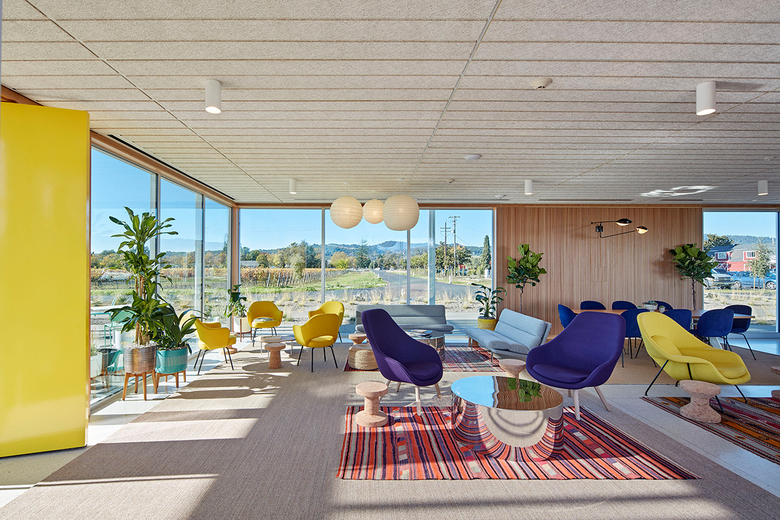U.S. Building of the Week
Ashes & Diamonds
Although Ashes & Diamonds is a young winery, having opened in Napa, California, in 2017, the design of its tasting room and production facility harkens back to the state's mid-century modern architecture. Bestor Architecture answered a few questions about their standout design.
Location: Napa, California, USA
Client: Ashes & Diamonds
Architect: Bestor Architecture
- Design Principal: Barbara Bestor, FAIA
- Project Manager: Danielle Yip
- Project Team: Sunny Lam, Cori Gunderson
Landscape Architect of Record: Creo Landscape Architecture
Associate Architect: vonRaesfeld & Associates
Structural Engineer: Vaziri Structural Engineering
Mechanical & Plumbing Engineer: TEP Engineering
Electrical Engineer: JRA Electrical Engineers, Brokaw Design
Interior Design: Bestor Architecture
Contractor: Facility Development Company
Construction Manager: Laurence Seaton, SEA-CON
Energy Consultant: SolData Energy Consulting
Kitchen Consultant: TriMark Federighi Design
Site Area: 30 acres
Building Area: 26,109 sf
The client, Kashy Khaledi, was familiar with Bestor Architecture’s design work and wanted to hire a firm that would design a modern winery experience that would embody and help define the fresh winery’s brand. He personally selected the firm.
Resting in rolling green mounds, the Ashes & Diamonds winery and event center lightly touches the ground and provides a relaxed indoor-outdoor space for gathering and tastings. The client required a serious production facility that could produce up to 10,000 cases of wine per year as a boutique winery and provide hospitality spaces that felt like a comfortable modern living room. Ashes & Diamonds' goal was to break down barriers to wine connoisseurship, and the new winery and event center represents a more accessible vibe to a new generation.
While there are nods to the mid-century, Palm Springs-style postcard fantasy, Bestor Architecture aimed for a lighter and more contemporary design fitting to the industrial nature of wine production and a more residential scale for the hospitality building. The modern design reflects the type of wine produced at Ashes & Diamonds; it is intended to have unbridled sense of possibility and optimism that was the engine for innovation in a progressive era.
Bestor Architecture designed the entire site, including the landscape, with a balance of straightforward building skeletons — pre-engineered metal building clad in insulated metal panels at the Production Building, wood-frame construction finished in stucco at the Hospitality Building. These provide a simple container for a more luxurious interior. We created standard steel sections that were prefabricated in large pieces off-site for the Hospitality canopy. The two buildings create a very public courtyard between. In that courtyard, which acts as an extension of the Hospitality Building & Tasting Room spaces, a rolling landscape with zig-zag paths cutting between the soft mounds provide varied views of the vineyards on site and the two buildings. The large Production Building provides an edge for the landscape and a bird’s eye view of the grounds for the staff from their offices located behind the large porthole windows at the second floor.
While the overall site plan and relationship of built elements across the site remained largely unchanged from the initial design stages, various sizes, shapes, and massings were explored for the Hospitality Building in order to maximize visibility from Hwy 29 without building too tall.
The design was intended to save costs by using prefabricated and readily available construction elements. Daylighting was used strategically where beneficial and avoided where not. Large expanses of glazing in the Hospitality Building, coupled with operable shades and the shade structure above, reduces the need for electric lighting and improves interior visual quality while mitigating heat gain. Glazing was minimized in the production areas to reduce heat gain in the highly temperature-sensitive barrel rooms.
Straightforward, simple methods of construction and prefabricating certain elements helped control costs and overall construction duration. The rich, varied interior finishes succeeded in adding a layer of warmth and richness to the simple shells. Crisp terrazzo, warm wood, jewel-toned fabrics, verdant paint and epoxy, and speckled linoleum combined to create warm, welcoming interior spaces that also flowed well with the surrounding meadow grasses, native plantings, and vineyards outside.
Email interview conducted by John Hill.












